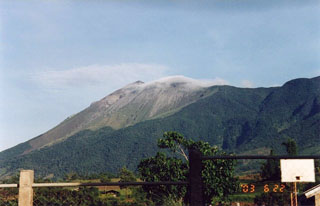Report on Kanlaon (Philippines) — 5 February-11 February 2025
Smithsonian Institution / US Geological Survey
Weekly Volcanic Activity Report, 5 February-11 February 2025
Managing Editor: Sally Sennert.
Please cite this report as:
Global Volcanism Program, 2025. Report on Kanlaon (Philippines) (Sennert, S, ed.). Weekly Volcanic Activity Report, 5 February-11 February 2025. Smithsonian Institution and US Geological Survey.
Kanlaon
Philippines
10.4096°N, 123.13°E; summit elev. 2422 m
All times are local (unless otherwise noted)
The Philippine Institute of Volcanology and Seismology (PHIVOLCS) reported continuing eruptive activity at Kanlaon during 4-11 February. The seismic network recorded 7-23 daily volcanic earthquakes, though during 5-6 February there was a total of 35 events. Average daily sulfur dioxide emissions ranged from 1,611 to 4,186 tonnes per day (t/d); emissions since 3 June 2024 averaged 4,484 t/d. Gas-and-steam emissions rose as high as 100 m above the summit and drifted W, WSW, and SW; plumes occasionally contained ash on 8 February.
A minor explosive eruption began at 1511 on 6 February and lasted for two minutes based on seismic and infrasound data. An ash plume rose 600 m above the summit and drifted SW, causing minor ashfall in Mercedes and San Luis in the Sag-ang barangay (neighborhood) to the SW. The plume was partly obscured by rainy weather. The explosion was detected by instruments 5 km E and produced a booming sound reported in the barangays of Yubo (WSW) and Sag-ang. A sulfur odor was noted in several barangays in La Castellana to the S. Lahars descended the Buhangin River which flows through La Castellana and Moises Padilla.
The National Disaster Risk Reduction and Management Council (NDRRMC) report issued at 0800 on 8 February stated that 9,835 people (3,106 families) were spread across 23 evacuation centers and another 8,383 people (2,651 families) were staying elsewhere. The Alert Level remained at 3 (on a scale of 0-5); the public was warned to stay 6 km away from the summit and pilots were warned not to fly close to the volcano.
Geological Summary. Kanlaon volcano (also spelled Canlaon) forms the highest point on the Philippine island of Negros. The massive andesitic stratovolcano is covered with fissure-controlled pyroclastic cones and craters, many of which are filled by lakes. The largest debris avalanche known in the Philippines traveled 33 km SW from Kanlaon. The summit contains a 2-km-wide, elongated northern caldera with a crater lake and a smaller but higher active vent, Lugud crater, to the south. Eruptions recorded since 1866 have typically consisted of phreatic explosions of small-to-moderate size that produce minor local ashfall.
Sources: Philippine Institute of Volcanology and Seismology (PHIVOLCS), The National Disaster Risk Reduction and Management Council (NDRRMC)

